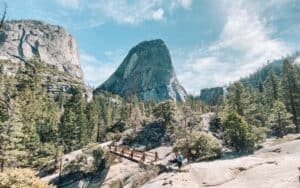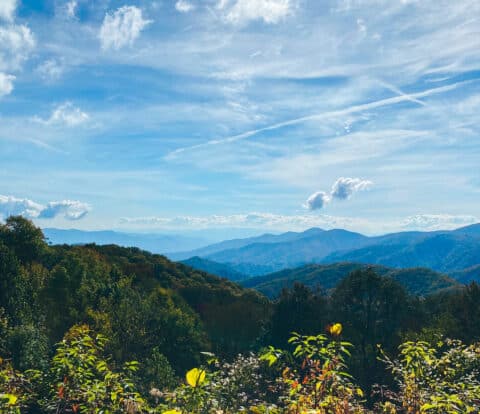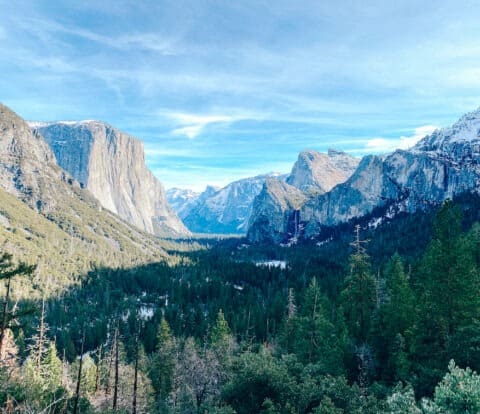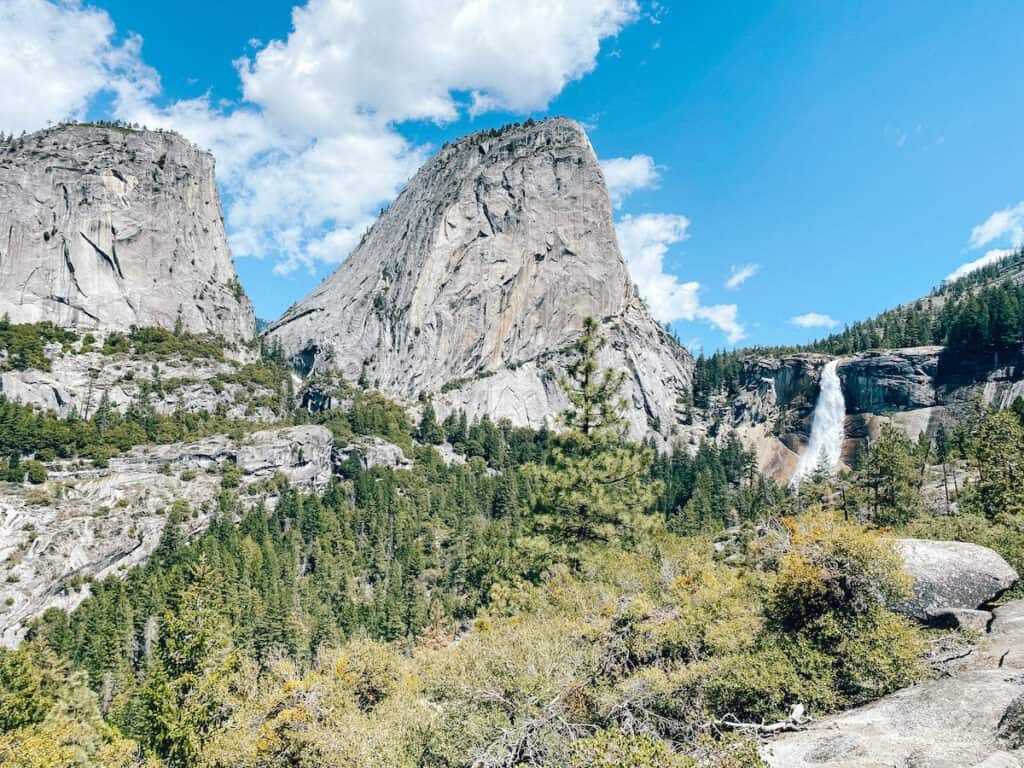
Yosemite National Park is one of those places you simply must see at least once in your lifetime. You could spend decades exploring Yosemite’s hundreds of miles of hiking trails, epic waterfalls, inspiring granite domes, and ancient groves of Sequoias. But assuming you only have a long weekend to spend here, you’re going to need the best 3 day Yosemite itinerary.
Over the past 30something years I’ve been lucky enough to visit Yosemite at least 20 times. I’ve learned the ins-and-outs of this incredible place, and put together the ultimate Yosemite 3 day itinerary to plan the perfect trip.
Over 3 days in Yosemite, you’ll see majestic waterfalls like Yosemite Falls, hike the iconic Mist Trail, explore the Mariposa Grove of Giant Sequoias, the high sierra and alpine lakes of Tioga Road, and marvel at views from Taft Point and Glacier Point.
You’ll also find helpful information on where to stay, getting around, and important must-know details about the new 2024 reservation system.
Disclosure: This page may contain affiliate links where I earn a small commission from any purchase – at no extra cost to you. This commission helps keep Brooke In Boots up and running. As always, all opinions are 100% honest and my own!
What to See in Yosemite National Park in 3 Days
If it’s your first visit to Yosemite National Park, here are my favorite must-do activities I recommend:
Day 1:
- The Mist Trail
- Yosemite Falls
- Dinner at the Ahwahnee Hotel
Day 2:
- Mariposa Grove of Giant Sequoias
- Glacier Point Road
- Taft Point and Sentinel Dome
- Glacier Point
Day 3:
- Tioga Road
- Cathedral Lakes or other hikes near Tioga Road
- Tenaya Lake
- Tuolumne Meadows
- Lembert Dome
This guide covers all of these stops in tons of detail, below, plus some more suggestions for how to spend an absolutely epic 3 days in Yosemite National Park. This itinerary assumes that you’ll be visiting when Glacier Point and Tioga roads are open, usually late spring to late fall.
I’ve also included important things to to know about planning your trip to Yosemite , below, including where to stay, how to get there, and important tips for traveling around Yosemite.
Update for 2024: Yosemite National Park will require day-use and peak-hours reservations to enter Yosemite for dates in February & April – October 2024. Learn more about these new changes, here.

How Many Days Should I Spend in Yosemite National Park?
A common question I get about visiting Yosemite is “how much time do I spend in Yosemite?” The answer? As much as you can!
If it’s your first visit to Yosemite and you’re visiting when all roads and areas of the Park are open (usually late May – November, more info on that below) I highly recommend spending at least 3 to 5 full days in Yosemite National Park.
With 3 days in Yosemite, you’ll have a chance to really explore several areas of this huge park, get in 1 or 2 good long hikes, see a few sunsets, and generally take in the experience without feeling rushed.
Have less time? Check out these 2 Day and 1 Day Yosemite itineraries to make the most out of even the shortest visits to Yosemite National Park.
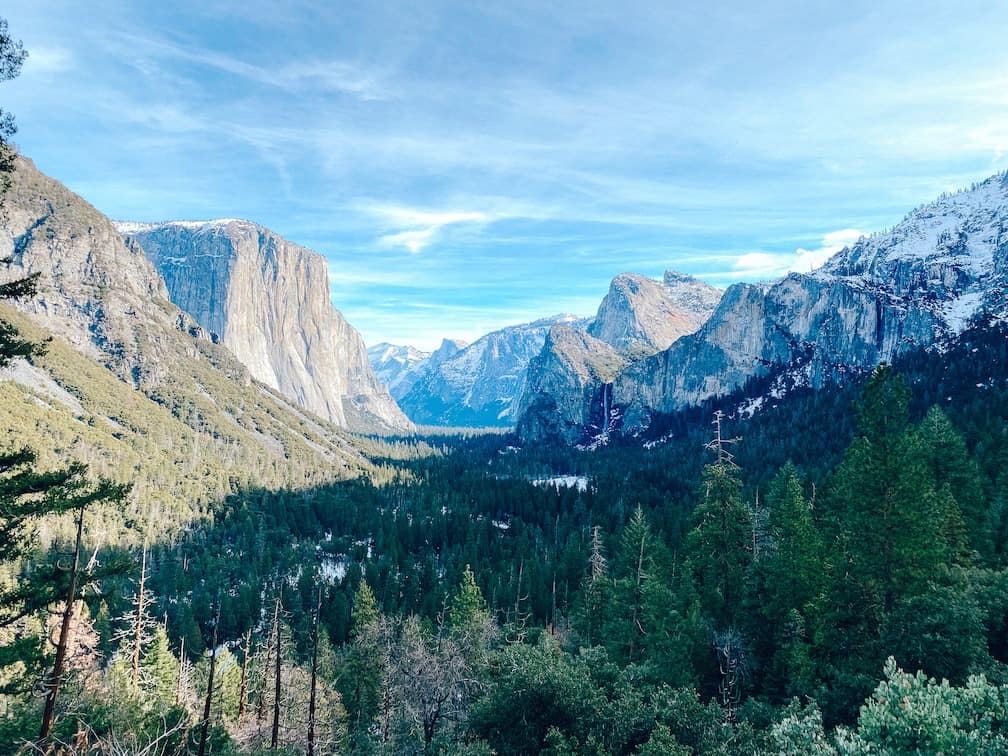
Important Things to Know About Yosemite National Park
Before planning your 3 day Yosemite itinerary, there are a few important things you need to know.
Where is Yosemite National Park?
Yosemite National Park is in the Sierra Nevada Mountains, in east-central California.
An important thing to remember is Yosemite is huge – about 748,000 acres, or about the size of the state of Rhode Island! There are also multiple entrances to the Park, some of which close Winter to late-Spring.
How to Get to Yosemite National Park
The closest major airports near Yosemite are San Francisco, Oakland, and Sacramento International Airports.
The cities of San Francisco and San Jose, California are approximately 4 hours drive from Yosemite Valley, depending on which Yosemite entrance you use. Los Angeles is about 7 hours from Yosemite.
Whatever airport you fly into, I recommend renting a car for your visit to Yosemite. Driving a car means you’ll have way more flexibility and won’t waste precious time waiting for a shuttle bus. You don’t need a 4×4 or high-clearance vehicle in Yosemite, any sedan can manage the roads fine during the summer months.
You can also take public transportation to Yosemite via the YARTS bus system. Buses run seasonally making stops from Fresno, Merced, Sonora, and Mammoth Lakes. You can fly or take the train to one of these towns and hop on the YARTS to Yosemite. It’s a long process, and not one that I’d recommend for time, but it is possible!
Always check the Yosemite NPS website before traveling to the Park for updated road, traffic, and reservation information.
Getting Around Yosemite
If you are staying outside the Valley, you can, park in one of the designated day-use parking lots:
Parking Lots fill to capacity early during late Spring to early Fall, especially on weekends and holidays. Plan to arrive before 9AM for day-use parking lots.
Once you’ve parked in Yosemite Valley, use the massively convenient Yosemite Valley Shuttle system.
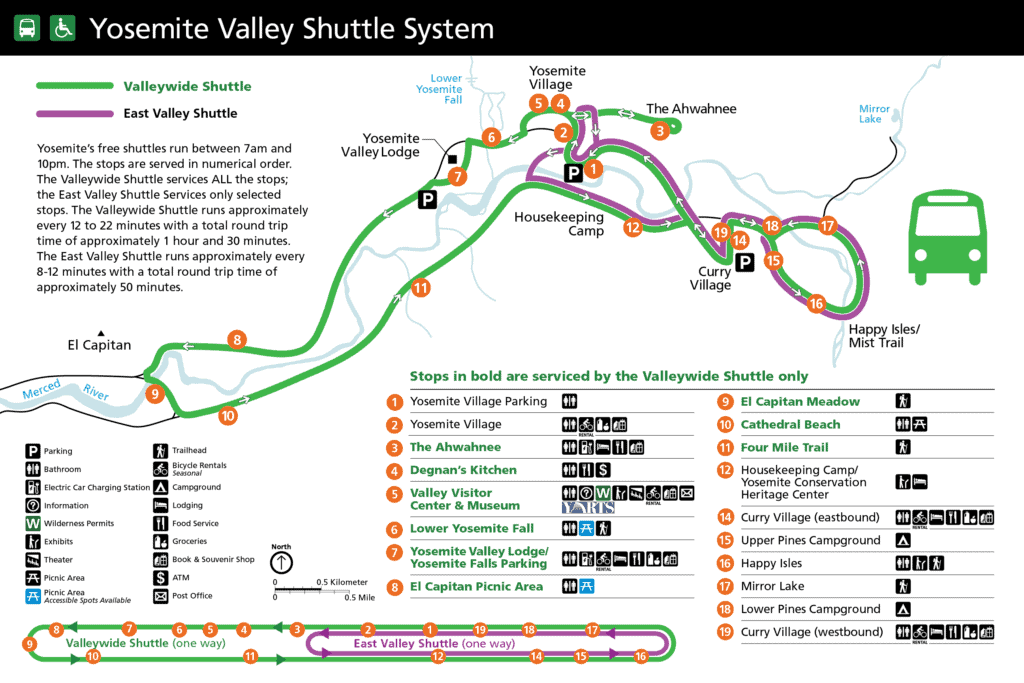
Two shuttle lines run in Yosemite Valley: the East Valley Shuttle; and the Valleywide Shuttle. Shuttles are free to use, run between 7am and 10pm, and arrive every 8 to 22 minutes.
Most major sights and trailheads within Yosemite Valley are serviced directly by a shuttle stop, and the rest are just a short 10 or 15 minute walk away.
There is no free shuttle between Yosemite Valley and Glacier Point or Tuolumne Meadows on Tioga Road. For shuttle service within the Tuolumne Meadows area you can use the Tuolumne Meadows shuttle. Parking is available at all trailheads along Tioga Road. If you get there early, you usually won’t have a problem finding a spot.
The Tuolumne Meadow Hiker shuttle picks up at the Yosemite Valley Lodge and Curry Village, with scheduled stops at popular trailheads in the Tuolumne Area. Reservations can be made online, here.
Is Yosemite Dog Friendly?
Surprisingly, Yosemite is one of the more dog friendly National Parks in California, although you’ll still be very limited where you can bring a dog here.
Dogs are permitted on fully paved roads, sidewalks, and bicycle paths, in campgrounds, and on Wawona Meadow Loop trail. Some lodging allows pets, and a seasonal kennel is available for day-use in Yosemite Village. Check out these easy hikes in Yosemite for ideas on where to bring your pooch during your visit!
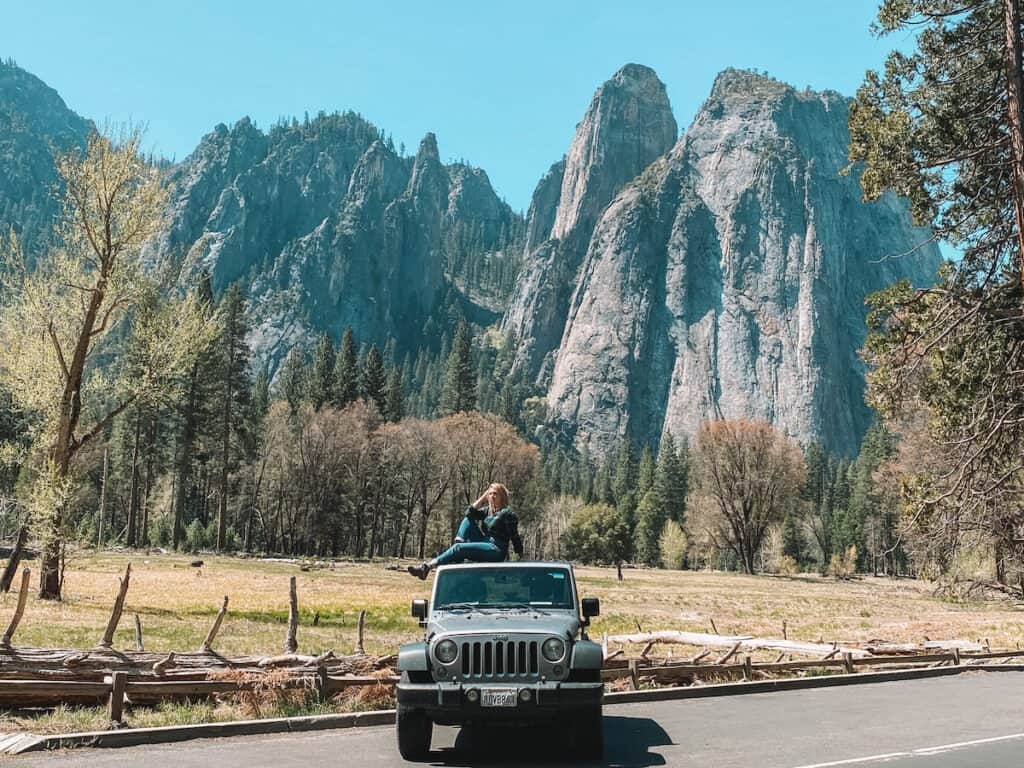
Entrance Fees & Reservations in Yosemite (Updated 2024)
There is an entrance fee of $35 per vehicle (or $20 per person if entering by foot bike or horse) for all visitors to Yosemite National Park.
Update for 2024: Yosemite National Park will require day-use and peak-hours reservations to enter Yosemite for dates in February & April – October 2024. Learn more about these new changes, here.
Traveling to more than 2 National Parks or National Forests this year? Purchase an America the Beautiful National Parks Pass for $80, which covers entrance fees at all National Parks and NPS managed sites.
Yosemite National Park is Indigenous Land
Yosemite Valley is the ancestral home to the Ahwahneeche. From the 1800’s through the 1960’s, indigenous residents of the Valley were killed and driven from the area by disease, settlers, militia forces, and even the National Park Service. The Miwok and Paiute continue to live in and around the central Sierra Nevada.
Today, many Yosemite landmarks pay tribute to the original indigenous owners of this land, including Tenaya Lake and the grand Ahwahnee Hotel.
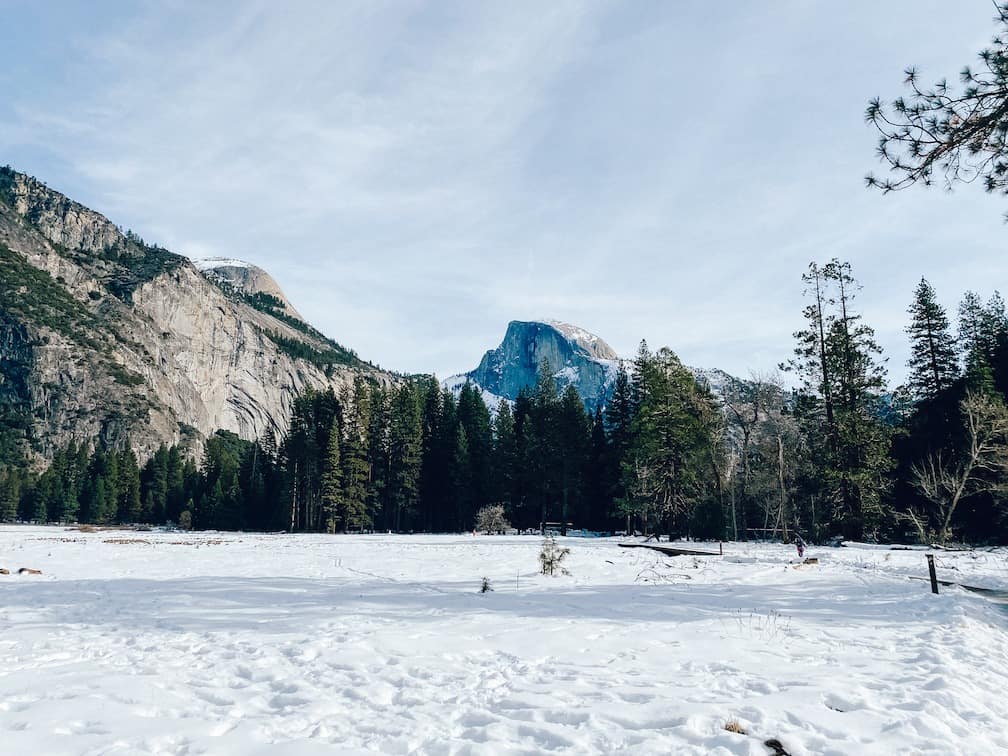
The Best Times to Visit Yosemite National Park
Park conditions change dramatically by season here, so deciding when to visit Yosemite is super important.
If this is your first visit to Yosemite, I suggest planning your trip during late-spring through late-fall. During that time most of the Park’s trails, roads, and sights are open.
Summer (June – September): Summer is by far the most popular time to visit Yosemite National Park. If you are able to reserve a coveted hotel, campground, or reservation to enter the park, expect hot days in the valley and lots of crowds. All major roads in the park are usually open by mid-June. In early summer, waterfalls are flowing, but nearly dry up by late summer.
Fall (September – November): Cooler temps with highs in the 50s and lows in the 30s. Most high sierra areas like Glacier Point and Tioga Road remain open until the first major snowfall, usually mid-November, but sometimes much later.
Winter (December – March): Glacier Point Road, Tioga Road, Mariposa Shuttle road close for the season, and dining and lodging options are limited. In exchange, you get to experience a winter wonderland, and snow play options, including Badger Pass Ski Area.
Spring (April – May): As snow melts, Yosemite’s waterfalls become roaring cascades. Tioga Road and Glacier Point usually open mid-May to early-June. Temps range from the 50’s to 70’s during the day, while night’s stay cold in the 30s or 40s.
Seasonal Road Closures in Yosemite
Check out the historic road and trail opening dates to get an idea of when roads typically close and open for the winter season. While these dates give a good approximation, it is impossible to know when exactly the high Sierra roads in Yosemite will open and close every year. Late spring snow storms are extremely common in this area.
The following is a rough approximation of winter road closures in Yosemite:
Tioga Road: closes by mid-November and reopens by early June.
Glacier Point Road: closes by mid-November and reopens by mid-May.
Mariposa Grove: closes by late November and reopens in May.
Take this itinerary to go! The printable Yosemite Itinerary Guide has your perfect 1, 2, or 3 day Yosemite trip completely planned for you! With over 20 pages of detailed hiking guides, printable daily itineraries, lodging and dining suggestions and more, you can spend less time planning and more time making epic memories! Check it out, here.
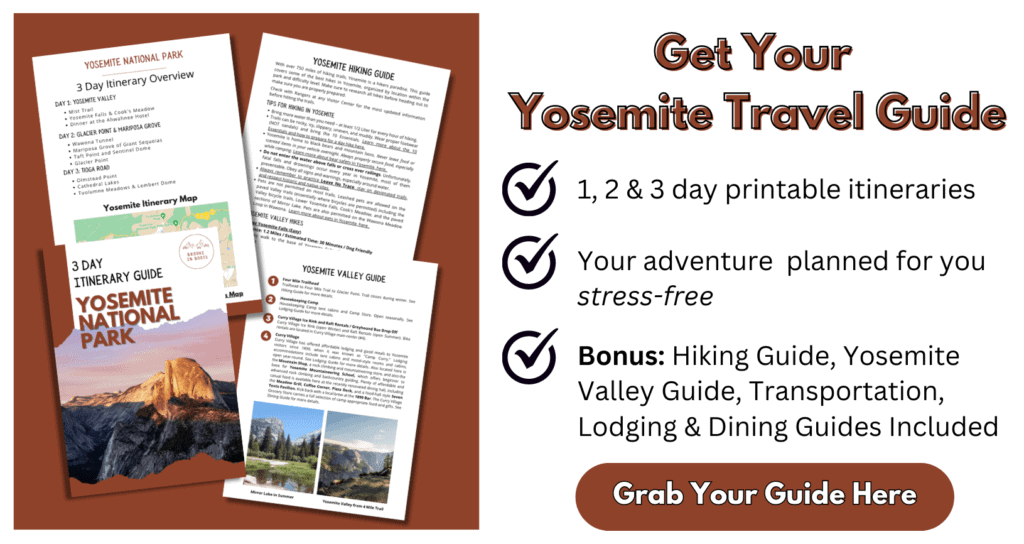

My Ultimate 3 Day Yosemite Itinerary
3 days in Yosemite allows for enough time to experience the best of Yosemite Valley, as well as some of the other areas of the Park, like Glacier Point, Tuolumne Meadows, and Tioga Road.
This itinerary assumes that you’ll be visiting when Glacier Point and Tioga roads are open, usually late spring to late fall.
If you’re entering or leaving the Park through Tioga Road (East Entrance), you’ll want to add in a couple of hours extra driving time when entering and leaving the Park.
You’ll save a whole bunch of time during your 3 days in Yosemite if you stay inside Yosemite Valley. I’ve included some suggestions for my favorite places to stay in Yosemite at the end of this post.
3 Day Yosemite Itinerary Map
This map shows the must-see stops on this 3 day Yosemite itinerary.
How to Use This Map: Click the Icons on the map to see more information about each location. Click the star at the top of the map to add the map to your Google Maps account.
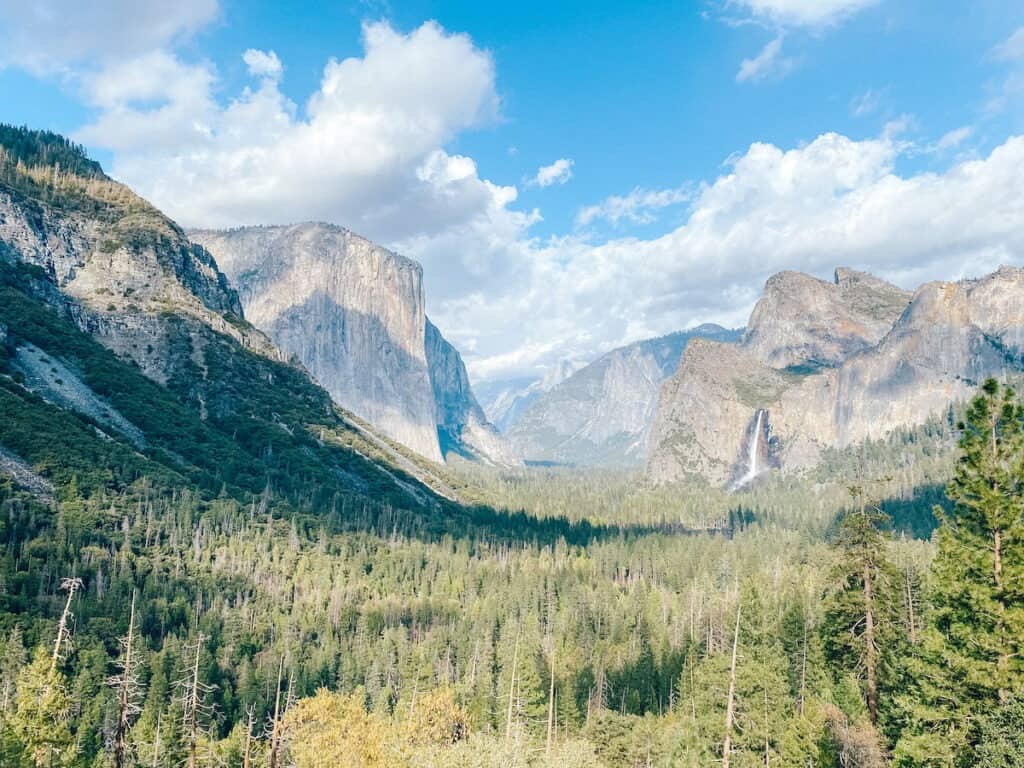
Day 1 in Yosemite: Yosemite Valley
Arriving in Yosemite Valley
If you are’t staying in Yosemite the night before, you’ll want to drive into the Park as early as possible!
Update for 2024: Yosemite National Park will require day-use and peak-hours reservations to enter Yosemite for dates in February & April – October 2024. Learn more about these new changes, here.
I suggest arriving at the Park entrance by 7am, or even earlier in the summer.
Don’t forget, remember that it takes 30 to 45 minutes to reach Yosemite Valley once you’ve entered the Park.
If you’re entering via the South/Wawona/Highway 41 Entrance, you’ll pass over Wawona Pass after entering the Park and descend via a windy road down to the Valley. Don’t miss stopping at the Wawona Tunnel Viewpoint, immediately after passing through the long Wawona Tunnel.
It’s impossible not to be totally awestruck by the view of Yosemite Valley below you from this spot. Park in the lot and grab a photo before continuing your drive.
For visitors entering from all other entrances – don’t worry, you’ll come back for this view later!

A Quick Stop at Bridalveil Falls
Bridalveil Falls cascades 620 feet into Yosemite Valley, and is often the first waterfall visitors encounter when entering the Park. Stop and park and walk the short 1/4 mile trail to the viewing platform. Enjoy the view – but don’t stay too long – you’ve got lots more to see!
Park Your Car & Grab Breakfast
The best parking is in the large day-use parking area, conveniently located near Yosemite Village, Yosemite Falls, the Shuttle, and the Visitor Center.
If you skipped breakfast this morning, head into Yosemite Village, the commercial and social hub of the Park, and grab a breakfast sandwich at Degnan’s Deli.
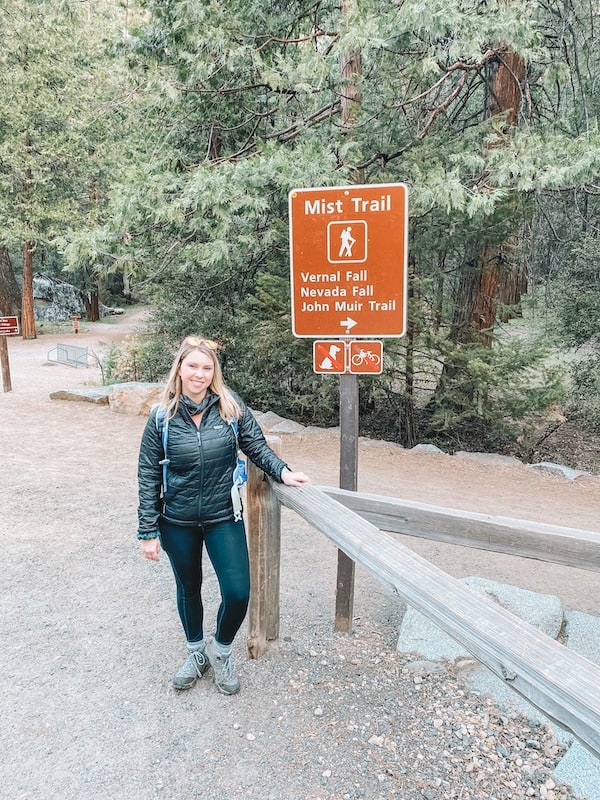
Take the Shuttle to Happy Isles
From Yosemite Village, walk to Shuttle Stops #1 (located on the east side of the day-use Parking Lot) or Shuttle Stop #2 (in front of the Village Store in Yosemite Village). Board the East Valley Shuttle to stop #16, Happy Isles.
If you are grabbing breakfast at Degnan’s or visiting the Visitor Center, you can also board the Valleywide Shuttle at Stops #4 (Degnan’s) or #5 (Visitor Center), which will take you to Happy Isles, but will take a little longer.
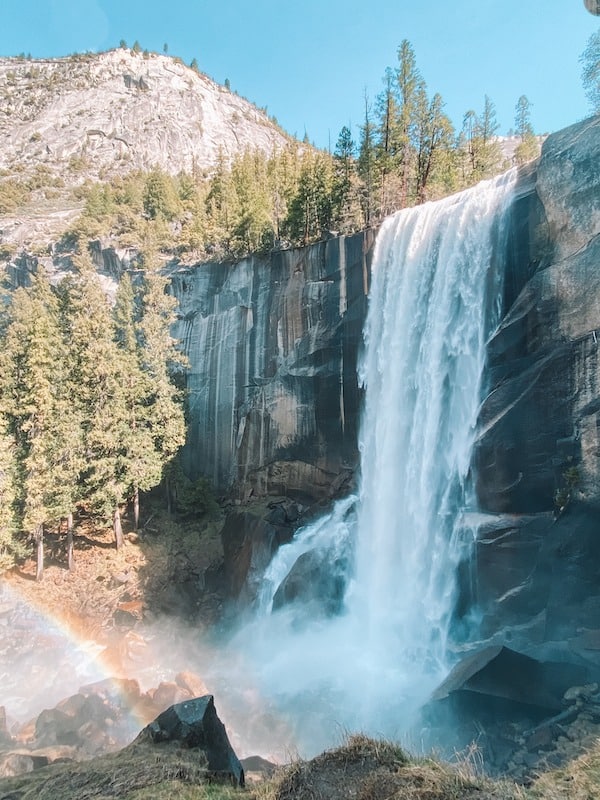
Hike the Mist Trail to Vernal or Nevada Falls
If there is one hike I absolutely insist you must do while visiting Yosemite, it is the “Mist Trail” to Vernal and Nevada Falls. This trail is one of my favorite day hikes of all time, and while it is strenuous, the reward is worth the effort!
Depending on your fitness level, and how much time you have, this trail has an option for everyone. Expect breathtaking views, a butt-blasting climb, giant waterfalls, and soaring granite cliffs.
From the trailhead, a steep but mostly paved trail climbs just under 1 mile to a wooden footbridge with views of Vernal Falls. From here you can snap photos and take a look at just how far you have to climb to the top.

Families with young kids and anyone who doesn’t want to commit to the longer hike can turn around here, but if you can, I absolutely suggest you keep going!
From the footbridge, the trail splits into the Mist Trail and the John Muir Trail. Follow the Mist Trail to Vernal Falls.
Along the way, you’ll climb more than 600 stone steps carved into the side of a spectacular waterfall. When water levels are high, you’ll definitely want a rain jacket! The “mist” trail gets its name from the constant spray off Vernal Falls soaking you on the trail.
Once you reach the top of Vernal Falls, take a snack break and catch your breath. Here you have the option of returning the way you came, or taking a worthy detour to Clark Point for spectacular views of distant Nevada Falls and the granite dome of Liberty Cap.
If you have the stamina, I suggest going all the way to Nevada Falls for unrivaled views and the feeling of being a total bad-a$% for climbing 2 massive waterfalls in one day! Return to the trailhead via the longer but more gentle John Muir Trail.
Mist Trail to Vernal and Nevada Falls ( 1-5 Hours)
Difficulty: Moderate to Strenuous
Depending on your fitness level, and how much time you have, there are several routes along the Mist Trail to Vernal Falls and Nevada Falls:
Vernal Footbridge: 1.6 Miles round trip / 1 Hour / Moderate / Elevation gain 400’
Beginner hikers and families with younger kids may want to consider hiking only to Vernal Falls or the Footbridge.
Vernal Falls Via Mist Trail: 2.4 Miles round trip / 3 Hours / Hard / Elevation gain 1,000’
Vernal Falls via Mist Trail and Clark Point via John Muir Trail: 4.2 Miles round trip / 4 Hours / Hard / Elevation gain 1550’
Vernal and Nevada Falls Via Mist Trail and Clark Point via John Muir Trail: 6.7 Miles round trip / 5-6 Hours / Strenuous / Elevation gain 1900′
Trail directions on All Trails. Check current conditions on NPS website, here.
Hiking the Mist Trail to Vernal and Nevada Falls is a serious adventure. Make sure you are prepared with the proper day hiking essentials, including sturdy waterproof hiking shoes, and rain gear.
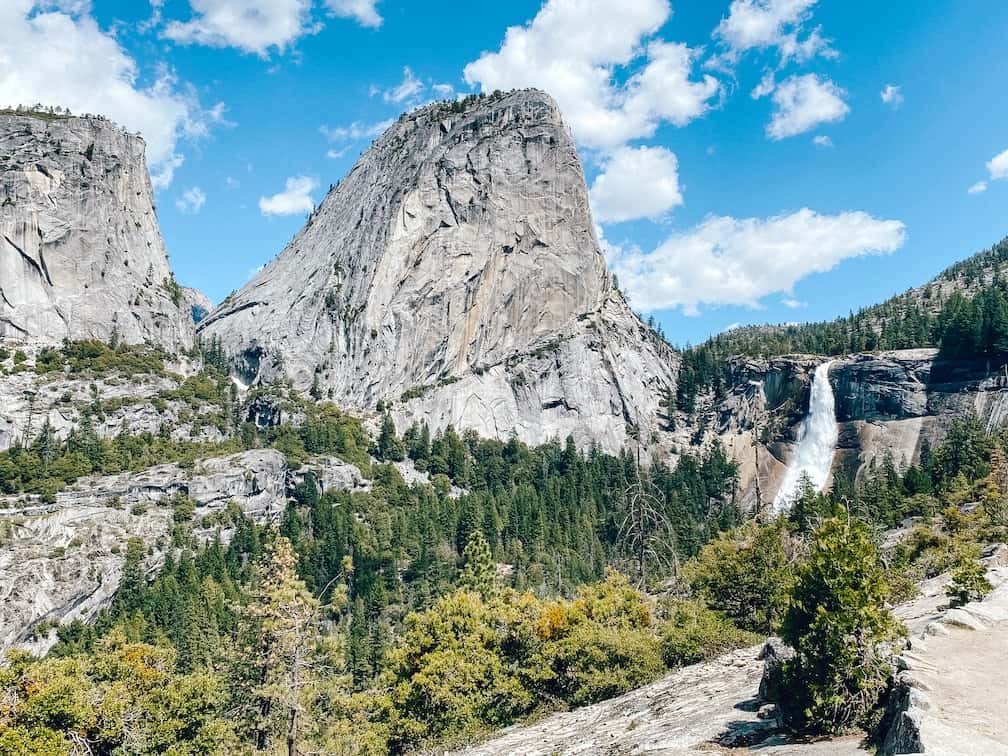
Lunch at Yosemite Village
Your legs are probably shaking thanks to the many, many stone stairs you just conquered. Enjoy sitting on the shuttle ride back to Yosemite Village.
Since you’ve probably worked up an appetite, grab quick snack or lunch in Yosemite Village at Degnan’s Deli (sandwiches, pizza, and other to-go options), The Loft at Degnan’s (pizza, BBQ and other casual lunch and dinner), or the Village Grill (summers only).

Yosemite Falls
Once you are refreshed, it’s time for an easy walk to Yosemite Falls. At 2,425 feet, Yosemite Falls is the tallest waterfall in North America, and an iconic sight you can’t miss on any trip to Yosemite.
The falls are actually 3 separate cascades, Upper Yosemite Falls (1,430 feet), the hidden middle cascades (625 feet), and Lower Yosemite Falls (320 feet).
The falls flow year-round, although they are little more than a trickle during late summer. During the peak spring snowmelt (May – June) an astounding 2,400 gallons PER SECOND flow over the top.
Walk west of the Yosemite Valley Visitor’s Center and follow signs for Yosemite Falls and the Lower Yosemite Falls trailhead. A fully paved and wheelchair-accessible path winds to the base of the falls.
Lower Yosemite Falls Trail
Difficulty: Easy / Wheelchair Accessible
1.2 Miles / Loop / 50 Feet Gain / 1 Hour
Trail directions on All Trails. NPS website information.

Check in to Your Hotel or Campground
At this point you could probably use a break, and definitely a shower if you’re hiking during summer. Check in to your hotel or campground and change out of your hiking clothes, because your next stop is a little more classy….
Dinner and Drinks at the Ahwahnee Hotel
If you aren’t staying in the Ahwahnee Hotel, make sure to swing by for drinks, dinner, or at least to people-watch at this stunning historic property. Built in 1927, this National Historic Landmark is considered the epitome of National Park Service Rustic Architecture – better known as “Parkitecture.”
To access the Ahwahnee, take the Valleywide Shuttle to Stop #3, or drive and self-park at the Hotel’s small parking lot. (The East Valley Shuttle does NOT access the Ahwahnee.)
After wandering through the lobby and Great Room, enjoy a drink in the bar and outdoor patio while watching the sunset on the granite cliffs around you. If you budget allows, enjoy dinner at the casually- elegant Ahwahnee Dining Room. Reservations are strongly suggested for dinner, but not required for the Bar. Lunch and Dinner service have been modified due to COVID – check here for current conditions.
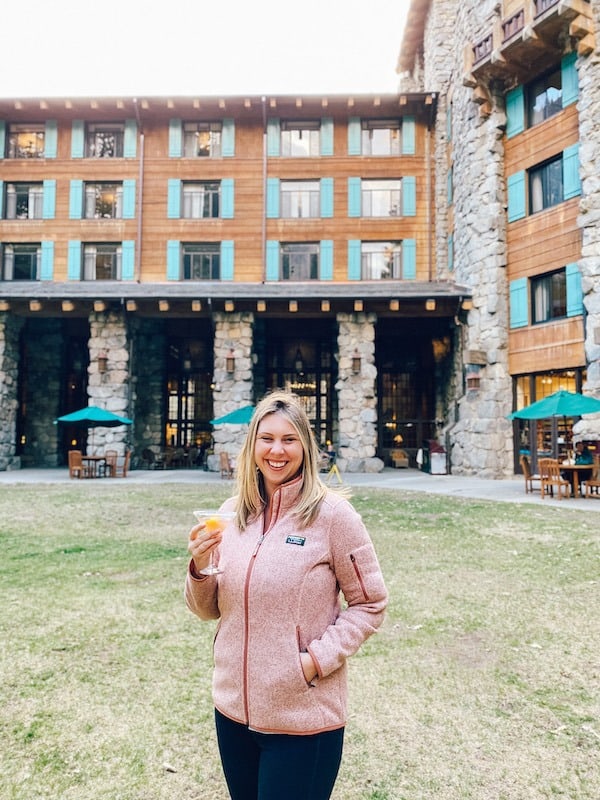
Yosemite Day 2: Mariposa Grove & Glacier Point
It’s time for another action-packed day in Yosemite. On day 2 you’ll leave Yosemite Valley behind and explore the Mariposa Grove, home to some of the largest trees on earth, and soar above the Valley at Glacier Point.
Breakfast and Cook’s Meadow
Enjoy a filling breakfast at your campsite or lodge (my favorite is the Basecamp Eatery at Yosemite Village Lodge) before heading out. If time allows, take your coffee to-go and enjoy a walk through Cook’s Meadow.
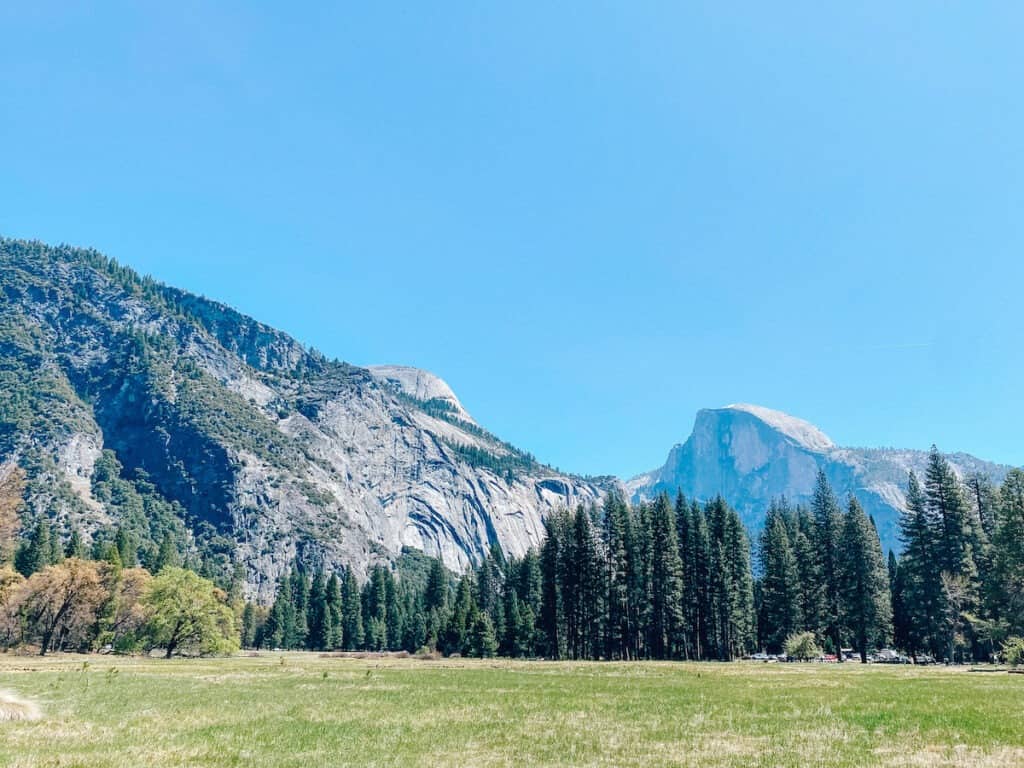
This 1 mile easy loop is easily accessed from Yosemite Village or the Lower Yosemite Falls shuttle stop. The wheelchair accessible boardwalk and paved path has stunning views of Half Dome and Yosemite Falls.
Drive to Mariposa Grove Welcome Plaza
From Yosemite Valley, drive to the Mariposa Grove Welcome Plaza, located near the Park’s south entrance on Wawona Road / Highway 41. The drive from Yosemite Valley takes approximately 1 Hour.
If you skipped the Tunnel View on the way into the Valley yesterday, don’t forget to stop here now and enjoy the view!
As you drive on Wawona Road, take note of the turn-off for Glacier Point Road, approximately 20 minutes past the Tunnel View. You will return here later this afternoon.

Park at the newly renovated Welcome Plaza and grab the free Shuttle to the Mariposa Grove of Giant Sequoias. The Shuttle operates seasonally, April through November, depending on conditions. Shuttles arrive every 10 to 15 minutes starting at 8AM and ending between 3:30 and 7PM (check website for specific operating times).
When the shuttle is not operating, the Grove is accessible via a 2 mile (one way) hike on a paved road.

Mariposa Grove of Giant Sequoias
Yosemite’s Mariposa Grove is home to over 500 Giant Sequoia trees. These impossibly huge trees are the largest trees in the world, and found only on the western slopes of the Sierra Nevada mountains of California. The Mariposa Grove is home to several “famous” trees, including the Grizzly Giant, the oldest tree in the grove at over 2,000 years old.
Hike the 2 mile Grizzly Giant Loop Trail for a short introduction to these magnificent, and endangered, giants.
Grizzly Giant Loop Trail
Difficulty: Easy to Moderate
2 Miles / 350′ Gain / 1.5 Hours
Trail Directions on All Trails. Check current conditions on NPS website, here.
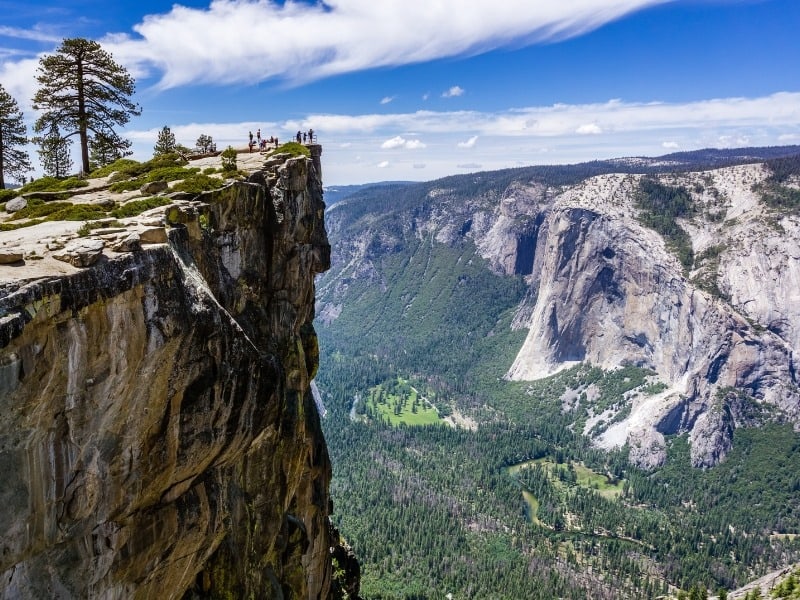
Glacier Point Road to Taft Point
After returning to your car, retrace your route down Wawona Road towards the Glacier Point Road turn-off you spotted earlier. Follow Glacier Point road as it winds and ascends into the high sierras. Drive carefully and obey all traffic signs – this road is winding with very steep drop offs and few railings.
It takes approximately 1 hour and 15 minutes to drive from the Mariposa Welcome Plaza to your next stop, Taft Point. Parking is available at Taft Point Trailhead Parking. This area can get pretty crowded, especially around sunset, so you may need to park along the side of the road, where permitted.
Taft Point is a large granite promontory with simply stunning views of Yosemite Valley and vertigo-inducing drops to the Valley Floor. “The Fissures” are giant cracks in the granite that drop all the way down to the Valley Floor, nearly 2,000′ feet below.
Hike the short trail to Taft Point – just watch your step! 👀
Taft Point Trail
Difficulty: Easy
2.3 Miles / 360′ Elevation Gain / 1 Hour
Trail Directions on All Trails. NPS Website Information
Take care when hiking in this area, obey all signs, stay inside the railings, and closely watch children near exposed cliffs and fissures.
If time permits, return to the trailhead and take a right for the hike to Sentinel Dome .
Sentinel Dome
Difficulty: Moderate
2.1 Miles / 450′ Elevation Gain / 1.5 Hours
Trail Directions on All Trails. Check current conditions on NPS Website, here.
A short scramble leads to the top of this granite dome, with 360 degree views of Yosemite Valley below, and absolutely breathtaking views of iconic Half Dome in front of you.
Sunset at Glacier Point
After you finish at Taft Point, drive the last 10 minutes up Glacier Point road to Glacier Point.
With breathtaking views of Yosemite Valley and the surrounding Sierra high country, it’s no wonder that Glacier Point is one of the most photographed spots in the entire Park. While sunset here is crowded, there’s simply nothing better than watching the light glow off the granite cliffs and peaks.
Restrooms, a parking lot, and a small gift shop are available at Glacier Point. After sunset, return to your hotel or campground and grab some dinner.

Yosemite Day 3: Tioga Road and Tuolumne Meadows
On the last day of your 3 day Yosemite itinerary, you’ll be exploring the Yosemite high sierra along Tioga Road.
For today, I suggest packing a picnic lunch and enjoying it in Tuolumne Meadows or Tenaya Lake. Don’t forget your hiking boots, hiking essentials, and plenty of water! If you feel like taking a cold plunge into Tenaya Lake, bring a bathing suit, towel, and some water shoes.
Yosemite Itinerary Tip: Tioga Road might take your breath away – literally. Tioga Pass crests at an elevation of 9,943 feet. That’s almost 6 thousand feet higher than Yosemite Valley! If you are unacclimated to hiking at higher altitude, expect even easy hikes to be more difficult. Learn more about how elevation affects your hiking here.
Breakfast and El Capitan Meadow
Grab an early breakfast and head to your car – you have a long day of driving and hiking ahead!
Don’t forget to pack some to-go sandwiches or other lunch fixin’s for your picnic in Tuolumne Meadows, later. Grab-and-go food is available at Degnan’s, the Village Store, and Base Camp Eatery.
Northside drive is the one-way road out of the Valley. On your way, stop quickly at El Capitan Meadow. Roadside parking is available just past the turnoff for El Capitan Drive. Take in this impressive view of “El Cap” (and be absolutely gobsmacked when you remember that Alex Honnold free solo climbed this monolith in 2016).
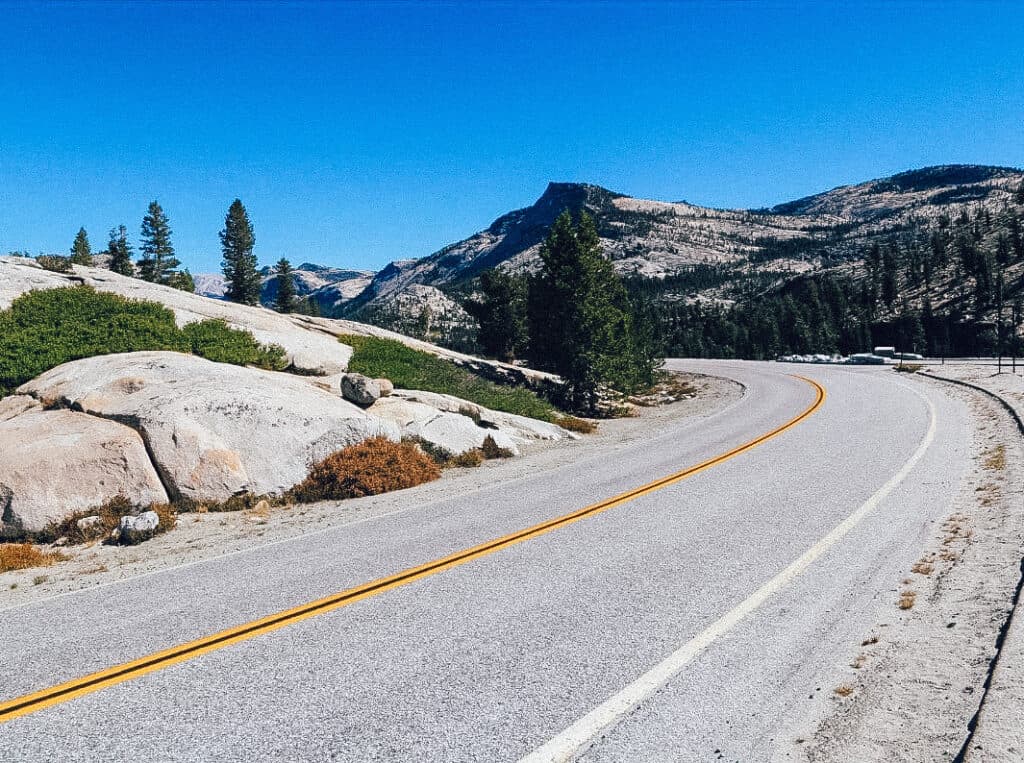
Tioga Road
Continue on Northside Drive, which turns into El Portal Road. Continue following signs for Highway 120 / Tioga Road. Approximately 20 minutes past El Cap Meadow, the road intersects with the Big Oak Flat entrance road, and one of the 2 gas stations inside the park.
I strongly suggest getting gas here, as gas is unavailable for the rest of your drive today.
Stay right to continue onto Tioga Road. Completed in 1919, Tioga Pass is the highest automobile mountain pass in the Sierras, and the highest in California.
Turn off for the Olmstead Point parking area along Tioga Road. An easy climb/walk over the granite plateau leads to stunning views of Half Dome, Cloud’s Rest, and the Sierra backcountry.
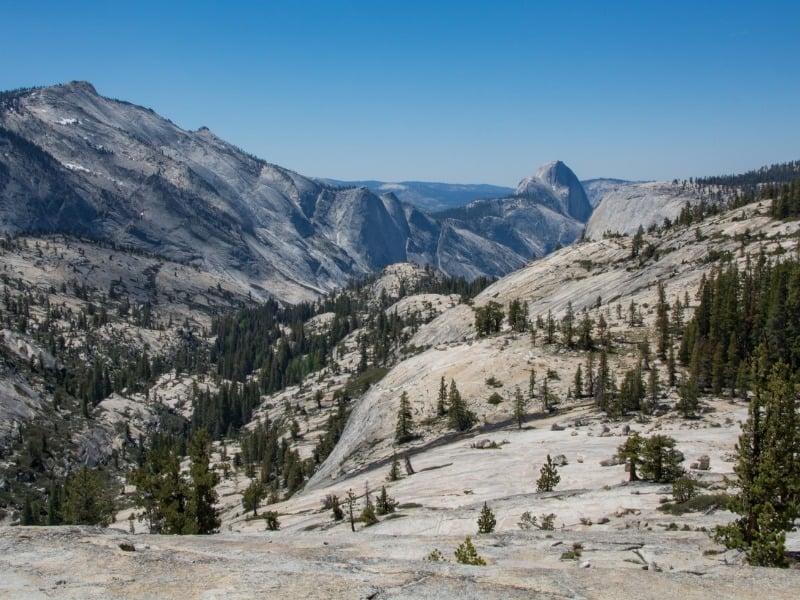
Cathedral Lakes Trail
This difficult but rewarding trail is one of the highlights of visiting Tioga Road. It is a moderate to strenuous hike, taking approximately 5 hours, but if you have time and energy, it is absolutely worth it!
If you aren’t up for this long of a hike, or perhaps you’re traveling with young kids, you can skip this stop. There are plenty of options for shorter hikes in Tuolumne Meadows coming up!
Cathedral Lakes Trail
Difficulty: Moderate
8 Miles / 1,600′ Elevation Gain (including spur trail to lower lake) / 5 Hours
Trail directions on All Trails. NPS website information.
Parking is available at a small lot at the trailhead. If the lot is full, more parking is available a the Tuolumne Meadows Visitor Center. From the visitor center, a connector trail leads to the Cathedral Lakes trailhead, adding about 1 mile total to your hike.
The trail is a steady incline right from the start. After about 2.5 miles, the trail splits. Take the trail on your right to Lower Cathedral Lake, about 0.5 miles ahead.
As you return to the main trail, you’ll have awesome views of the granite spires of Cathedral Peak directly in front of you.
Follow the John Muir Trail and continue to climb for about another mile before arriving at your destination of Upper Cathedral Lakes. Here you’re basically surrounded on all sides by granite peaks and a glittering alpine lake. Enjoy a well-deserved snack break and take in the sublime view before returning to the trailhead via the John Muir Trail.

Tenaya Lake
Surrounded by the granite spires of the Yosemite backcountry, Tenaya Lake is a stunning must-see spot on your Yosemite itinerary. The natural beach makes this a super popular spot for picnicking and swimming in summer.
If you just hiked to Cathedral Lakes, this makes an incredible spot to relax, enjoy some lunch, and maybe take a cool dip in the alpine waters.
Several hikes leave from this area, depending on your time and appetite for hiking today. The easy Tenaya Lake Trail follows the east shore of the lake for approximately 3.4 miles (out and back). The more strenuous Sunrise Lakes Trailhead (6.7 miles/ 4 Hours) is located at the south end of the lake, along Tioga Road.

Tuolumne Meadows Visitor Center
Return to your car and head to the Tuolumne Meadows Visitor Center. The Visitor Center has a small exhibit about the Tuolumne Meadows area and high sierra backcountry, as well as a bookstore and ranger desk.
If you didn’t pack a picnic lunch, the nearby Tuolumne Meadows Grill (3 minutes drive / 20 minutes walk from Visitor Center) serves hearty hiker-food, like burgers, hot dogs and chili.

Tuolumne Meadows
The last stop on Tioga Road today is Tuolumne Meadows. Tuolumne Meadows is a massive sub-alpine meadow surrounded by miles and miles of Yosemite backcountry.
You’ll get spectacular views of the meadows from the Tuolumne Meadows Visitor Center, and as you continue driving up Tioga Road.
If you aren’t totally exhausted from this morning’s hike, you can opt for the short but steep hike to nearby Lembert Dome (about 1.5 hours, round trip) or combine this trail with a longer hike to Dog Lake (
To Lembert Dome, park at the Dog Lake parking area, located on Tuolumne Meadows Lodge Road, past the Wilderness Center and Ranger Station.
The trail climbs steadily through the forest for the first 0.5 miles. Keep left at the trail junction towards Lembert Dome. After another 0.2 miles, the forest opens up to a large granite dome in front of you. From here, scramble over the granite to the top of the dome and take in 360 views of the meadow and Yosemite high country.
Avoid this hike during rain and thunderstorms. If thunderstorms approach, immediately hike down from the dome.
Lembert Dome
Difficulty: Moderate
1.8 Miles to Lembert Dome, round trip (1.5 Hours)
Trail description on All Trails. NPS website information.
As an alternative, consider the easy and family-friendly hike to the naturally-bubbling Soda Springs and Parsons Memorial Lodge, (1.6 Miles round trip / easy) which hosts seasonal ranger-talks and exhibits.
Return to Yosemite Valley
After a long day, you’re ready to return to Yosemite Valley.
Return the way you came via Tioga Road, following signs for Yosemite Valley. If you have time, consider stopping by Tunnel View (1.5 Hours from Tuolumne Meadows Visitor Center) for a stunning another sunset over the Valley for your last night in Yosemite.
Return to the Valley for dinner and celebratory drinks at Bar 1899 (at Curry Village Basecamp Eatery) or the Mountain Room Lodge (Yosemite Lodge) as you enjoy the end of your 3 perfect days in Yosemite National Park!
Take this itinerary to go! The printable Yosemite Itinerary Guide has your perfect 1, 2, or 3 day Yosemite trip completely planned for you! With over 20 pages of detailed hiking guides, printable daily itineraries, lodging and dining suggestions and more, you can spend less time planning and more time making epic memories! Check it out, here.

Where to Stay in Yosemite National Park
Yosemite has dozens of in-Park lodges, hotels, and 13 popular campgrounds, many open all year. If you can, try and book reservations to stay INSIDE Yosemite National Park.
Why? With traffic, it can take hours, literally, to drive from lodging outside the Park to the Valley. And don’t even get me started on parking (check out tips for parking in “Getting Around Yosemite”).
When you stay in the Valley, you can park your car, hop on the shuttle and, most importantly, visitors who stay inside the park don’t need a separate peak-hours reservation to enter the park!
Update for 2024: Yosemite National Park will require day-use and peak-hours reservations to enter Yosemite for dates in February & April – October 2024. Learn more about these new changes, here.
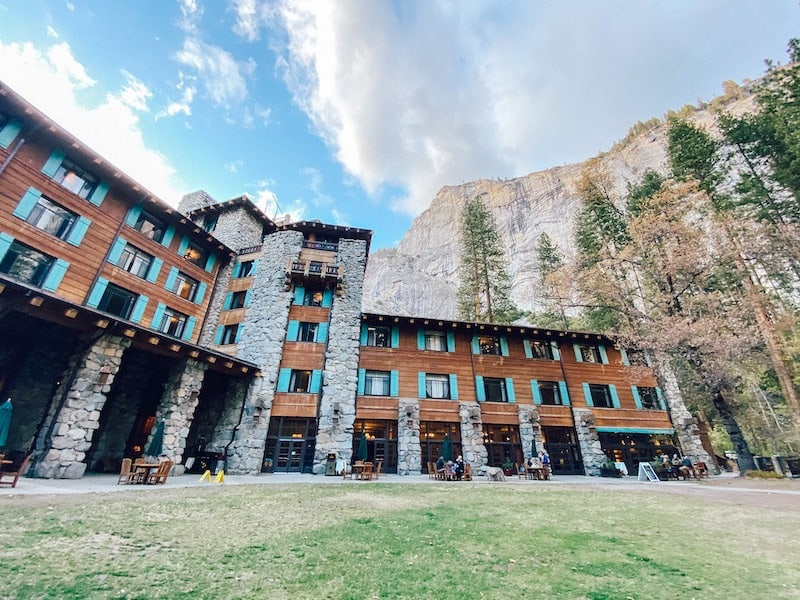
Hotels and Lodges Inside Yosemite Valley
Yosemite Lodge: Family-friendly, plenty of food and drink options, swimming pool, recreation rentals, and centrally located to Yosemite Falls, Yosemite Village, and Shuttle Stops. My go-to, and it never lets me down.
Curry Village: “Glamping” style tent-cabins, if you want the camping experience, without having to bring the tent. Curry Village also offers several motel-style cabins that are an incredible value (and reasonably comfortable, I can vouch!). Multiple dining options, bike rentals, winter ski-rink, summer swimming pool, located walking distance to the Happy Isles / Mist Trail / John Muir Trailheads
Housekeeping Camp: Curry Village, with less amenities. More “camping” than “glamping” – but perfect for families and visitors ok with roughing it.
The Ahwahanee Hotel: The crown jewel of the National Parks hotels and lodges. Presidents have stayed here. The Queen has stayed here. Not a Rockefeller? 100% come for a dinner reservation at the historic dining room (check the dress code), or grab a post-hike drink at their casual bar (my favorite!).

Campgrounds Inside Yosemite Valley
The following campgrounds are located inside Yosemite Valley: Upper Pines (Open All Year); Lower Pines (April-October); North Pines (April-October); Camp 4 (Open All Year).
All campgrounds are reservation only while the “peak-hours” permit system is in effect in 2022. Book your campground reservations as soon as possible. Yosemite campground reservations often sell out within seconds (yes, you read that right) of going online. Reservations are all managed through Recreation.gov. Campground reservations become available 5 months in advance, on the 15th of each month at 7AM Pacific Time. Camp 4 offers one day in advance reservations by lottery, available on Recreation.Gov.
Planning a camping trip as part of your Yosemite itinerary? Don’t forget any of the essentials with the Ultimate Tent Camping Setup Guide with printable camping checklist!
Having trouble booking hotel or campground reservations? Check out my Tips for Planning an Epic National Parks Trip – including how to book reservations in popular parks, like Yosemite.
Hotels, Lodges, and Campgrounds Outside Yosemite Valley (But Inside Yosemite National Park)
The following lodges, hotels, and rentals are located outside Yosemite Valley (but still inside Yosemite National Park): Wawona Hotel, High Sierra Camps, Redwoods in Yosemite, Yosemite West Rentals, White Wolf Lodge, Tuolumne Meadows Lodge, and Glacier Point Ski Hut.
The following campgrounds are located outside Yosemite Valley (but still inside Yosemite National Park): Tamarack Flat Campground (Seasonal, Tioga Road Corridor); White Wolf Campground (Seasonal, Tioga Road Corridor); Yosemite Creek Campground (Seasonal, Tioga Road Corridor); Wawona Campground (Open All Year); Bridalveil Creek (Seasonal, closed 2022); Hodgdon Meadow (Open All Year, North Yosemite); Crane Flat (closed 2022, North Yosemite); Porcupine Flat (closed 2022); and Tuolumne Meadows (Seasonal, Closed Until 2024 -2025).
Learn more about Campgrounds and Campground reservations in Yosemite National Park, here.
Backcountry camping is also available to wilderness permit holders only. Learn more about these competitive wilderness permits, here.
More Yosemite Posts to Plan Your Next Trip
17 Amazing Easy & Short Hikes in Yosemite National Park
Yosemite Reservations and Permits 2024: Everything You Need to Know
Best Entrance to Yosemite National Park & Tips for Driving to Yosemite
Hiking the Mist Trail to Vernal and Nevada Falls in Yosemite

